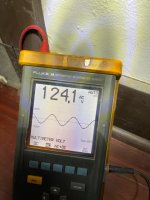winnie
Senior Member
- Location
- Springfield, MA, USA
- Occupation
- Electric motor research
You probably are connected across a switch leg instead of a hot and neutral.
The distorted waveform has vaguely sine shaped peaks with long absolutely flat '0' periods. It sure looks to me like you are measuring voltage in series with some sort of rectifying load. Maybe some 4 foot fixtures converted to LED or similar.

